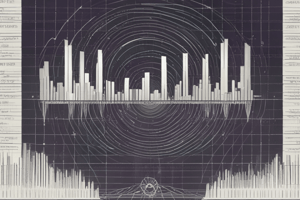Podcast
Questions and Answers
What does the Data-Ink Ratio measure?
What does the Data-Ink Ratio measure?
- The proportion of 'data-ink' to the total amount of ink used in a table or chart (correct)
- The relevance of the chart to the data
- The size of the data set
- The number of elements in a chart
What is the purpose of creating a summary table for data visualization?
What is the purpose of creating a summary table for data visualization?
- To reduce the size of the data set by highlighting important relationships and trends (correct)
- To confuse the audience with unnecessary information
- To make the data more difficult to interpret and analyze
- To save time by avoiding the creation of charts
According to Edward R. Tufte, what does the Data-Ink Ratio encourage chart creators to examine?
According to Edward R. Tufte, what does the Data-Ink Ratio encourage chart creators to examine?
- If all colors used in the chart are vibrant
- If there are enough annotations in the chart
- If all elements in the chart are relevant to the chart's message (correct)
- If the chart is visually appealing to the audience
What is one of the benefits of Data-ink optimized charts?
What is one of the benefits of Data-ink optimized charts?
What is the role of a clear message in data visualization?
What is the role of a clear message in data visualization?
What is one of the erasing principles mentioned in the text?
What is one of the erasing principles mentioned in the text?
Which type of chart is a graphical means of visualizing three variables in a two-dimensional graph?
Which type of chart is a graphical means of visualizing three variables in a two-dimensional graph?
What type of chart is useful for time series data collected over some time?
What type of chart is useful for time series data collected over some time?
Which type of table provides a tabular summary of data for two variables?
Which type of table provides a tabular summary of data for two variables?
What kind of data visualization tool illustrates multiple metrics and automatically updates these metrics as new data become available?
What kind of data visualization tool illustrates multiple metrics and automatically updates these metrics as new data become available?
What type of graphical representation of data uses different shades of color to indicate magnitude?
What type of graphical representation of data uses different shades of color to indicate magnitude?
How should text and numbers be aligned in a table for easier reading?
How should text and numbers be aligned in a table for easier reading?
When should tables be used instead of charts?
When should tables be used instead of charts?
What should be done to reduce redundant data-ink in charts and tables?
What should be done to reduce redundant data-ink in charts and tables?
What kind of chart is a common form of chart used to compare categorical data?
What kind of chart is a common form of chart used to compare categorical data?
How can GIS be applied in business site selection?
How can GIS be applied in business site selection?
Flashcards are hidden until you start studying
Study Notes
Data Visualization
- The Data-Ink Ratio measures the proportion of ink used to display actual data to the total amount of ink used in a graph.
- Creating a summary table for data visualization helps to organize and summarize data, making it easier to understand and visualize.
- According to Edward R. Tufte, the Data-Ink Ratio encourages chart creators to examine the efficiency of their graphical designs and eliminate non-data ink.
Benefits of Data-Ink Optimized Charts
- One of the benefits of Data-ink optimized charts is that they effectively communicate information, allowing viewers to quickly understand the data.
Role of Clear Message in Data Visualization
- A clear message in data visualization is crucial to effectively communicating information and avoiding confusion.
Erasing Principles
- One of the erasing principles mentioned in the text is to eliminate non-data ink.
Types of Charts
- A 3D scatter plot is a graphical means of visualizing three variables in a two-dimensional graph.
- A line chart is useful for time series data collected over some time.
- A contingency table provides a tabular summary of data for two variables.
- A dashboard is a data visualization tool that illustrates multiple metrics and automatically updates these metrics as new data become available.
- A choropleth map is a graphical representation of data that uses different shades of color to indicate magnitude.
Designing Tables
- In a table, text and numbers should be aligned for easier reading.
When to Use Tables Instead of Charts
- Tables should be used instead of charts when exact values are important, or when the data requires precise comparison.
Reducing Redundant Data-Ink
- To reduce redundant data-ink in charts and tables, eliminate non-data ink and focus on displaying only essential information.
Common Charts
- A bar chart is a common form of chart used to compare categorical data.
GIS in Business Site Selection
- GIS (Geographic Information System) can be applied in business site selection to analyze demographic data, traffic patterns, and other location-specific factors.
Studying That Suits You
Use AI to generate personalized quizzes and flashcards to suit your learning preferences.




